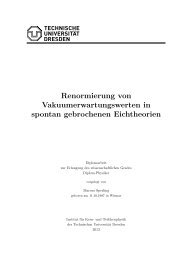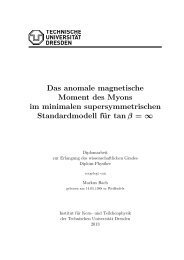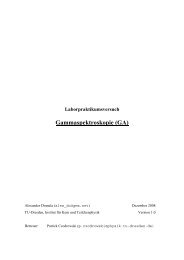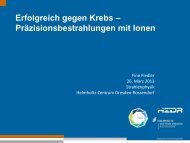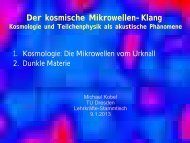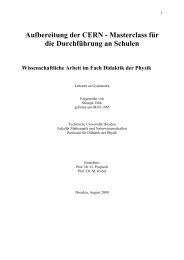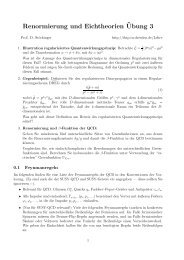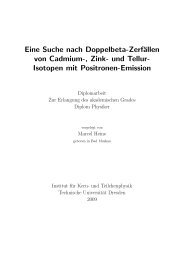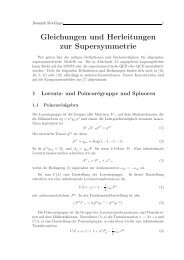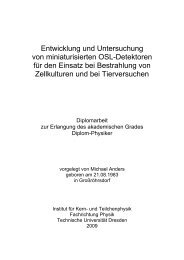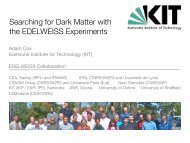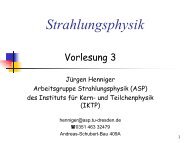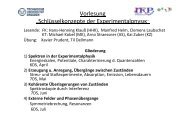A Mathematica based Version of the CKMfitter Package
A Mathematica based Version of the CKMfitter Package
A Mathematica based Version of the CKMfitter Package
You also want an ePaper? Increase the reach of your titles
YUMPU automatically turns print PDFs into web optimized ePapers that Google loves.
14 Chapter 3. <strong>CKMfitter</strong><br />
The quantity minimized in <strong>the</strong> fit is<br />
χ 2 = −2 ln L(ymod) , (3.1)<br />
with <strong>the</strong> likelihood function L(ymod), defined by a product <strong>of</strong> contributions <strong>of</strong> two<br />
types:<br />
L(ymod) = Lexp(xexp − x<strong>the</strong>o(ymod)) · L<strong>the</strong>o(yQCD) . (3.2)<br />
The experimental likelihood Lexp depends on <strong>the</strong> experimental measurements xexp,<br />
which are gaussian distributed in general, and <strong>the</strong>ir <strong>the</strong>oretical predictions x<strong>the</strong>o,<br />
which are functions <strong>of</strong> <strong>the</strong> model parameters ymod. The <strong>the</strong>oretical likelihood L<strong>the</strong>o<br />
describes <strong>the</strong> knowledge on <strong>the</strong> QCD parameters yQCD ∈ {ymod}, where <strong>the</strong> <strong>the</strong>oretical<br />
uncertainties σsyst are considered to define allowed ranges:<br />
[yQCD − σsyst, yQCD + σsyst] . (3.3)<br />
In <strong>the</strong> Rfit scheme, <strong>the</strong> <strong>the</strong>oretical likelihoods L<strong>the</strong>o(i) do not contribute to <strong>the</strong> χ 2<br />
<strong>of</strong> <strong>the</strong> fit, as long as <strong>the</strong> yQCD take on values within <strong>the</strong>ir.<br />
3.2 Fit Metrology<br />
is determined with<br />
In a first step, <strong>the</strong> global minimum <strong>of</strong> Equation (3.1), χ2 min,global<br />
respect to all Nmod parameters. Due to <strong>the</strong> experimental and <strong>the</strong>oretical systematics,<br />
this absolute minimal value does in general not correspond to a unique ymod location.<br />
In a second step, a selected subspace <strong>of</strong> interest <strong>of</strong> <strong>the</strong> parameter space, e. g. a =<br />
{¯ρ, ¯η} is scanned, to determin <strong>the</strong> local χ2-minimum χ2 min,local (a) for each fixed point<br />
<strong>of</strong> a grid in <strong>the</strong> parameter space a, with respect to <strong>the</strong> remaining parameters. The<br />
<strong>of</strong>fset-corrected χ2 is calculated as follows:<br />
∆χ 2 (a) = χ 2 min,local (a) − χ2 min,global<br />
where its minimum is equal to zero by construction.<br />
, (3.4)<br />
Finally, a confidence level (CL) for a is obtained using <strong>the</strong> well-known PROB function<br />
from <strong>the</strong> CERN Program Library [18]:<br />
1 − CL = P rob � ∆χ 2 �<br />
(a), Nd<strong>of</strong><br />
=<br />
which assumes gaussian statistics.<br />
1<br />
√ 2 Nd<strong>of</strong> Γ (Nd<strong>of</strong> /2)<br />
� ∞<br />
χ 2 (ymod)<br />
(3.5)<br />
e −t/2 t Nd<strong>of</strong> /2−1 dt , (3.6)



